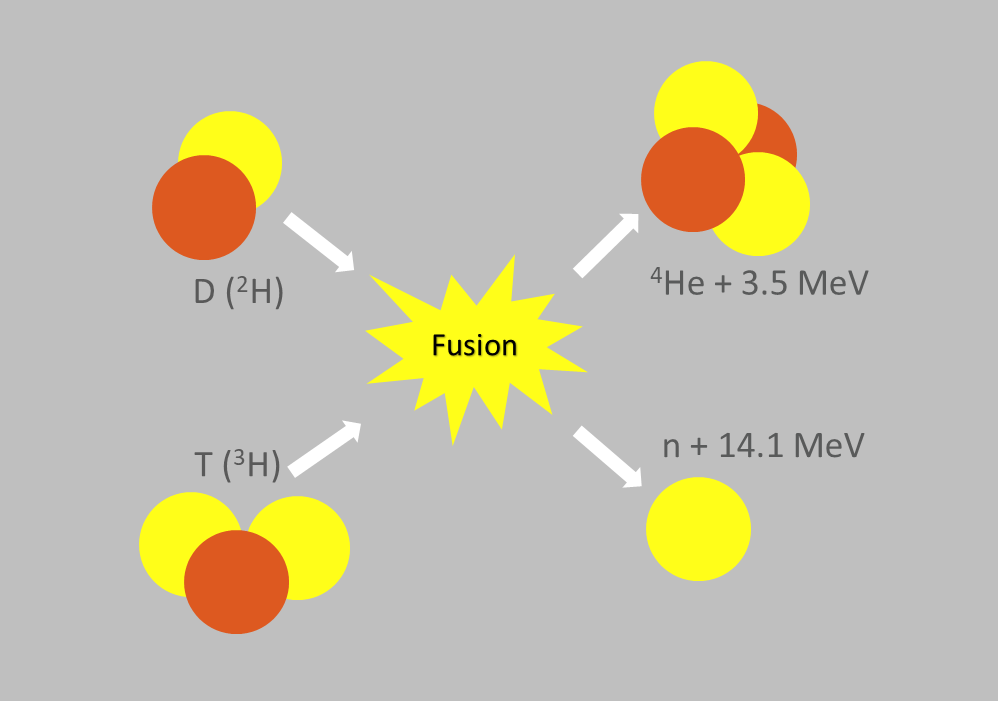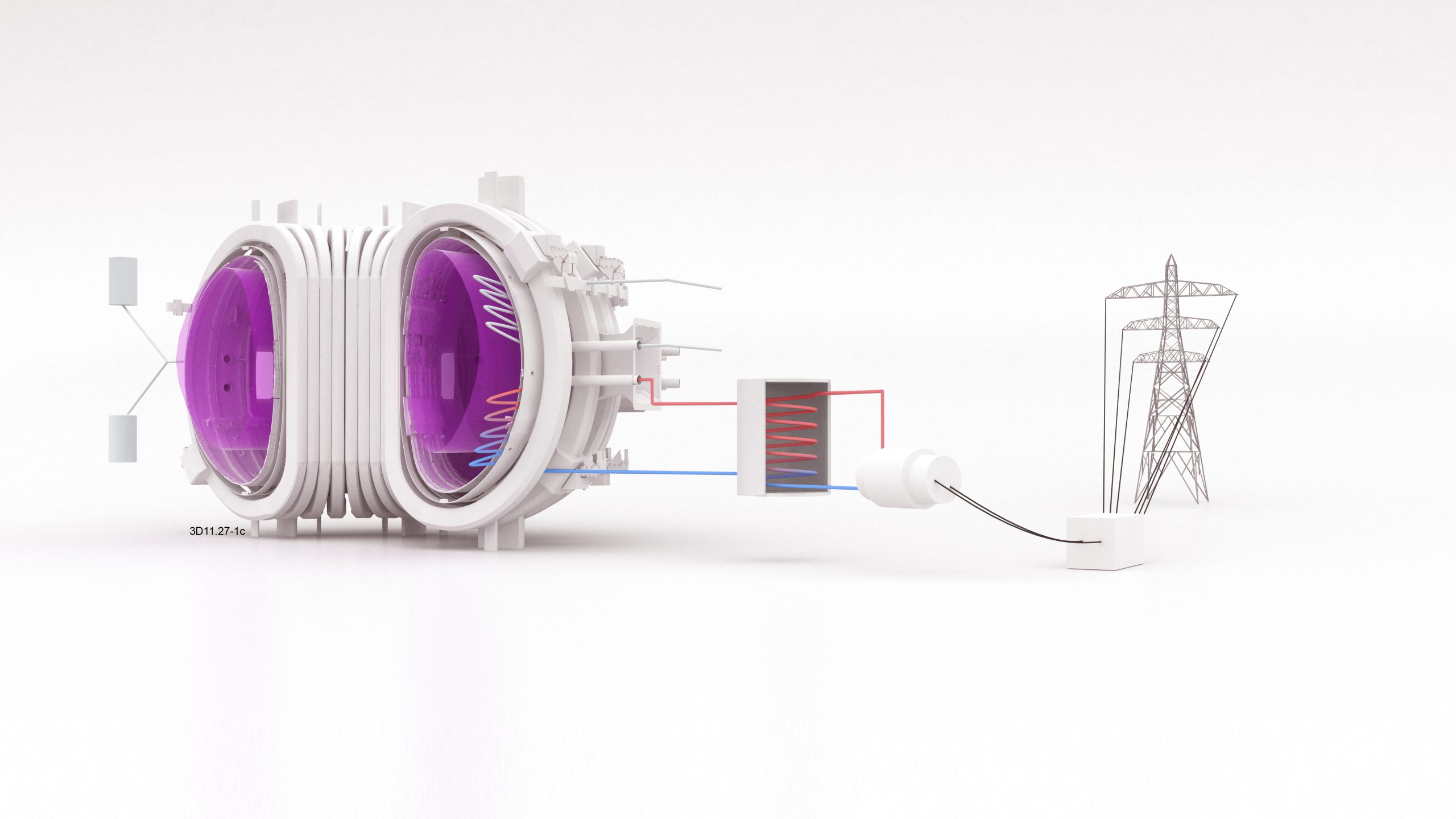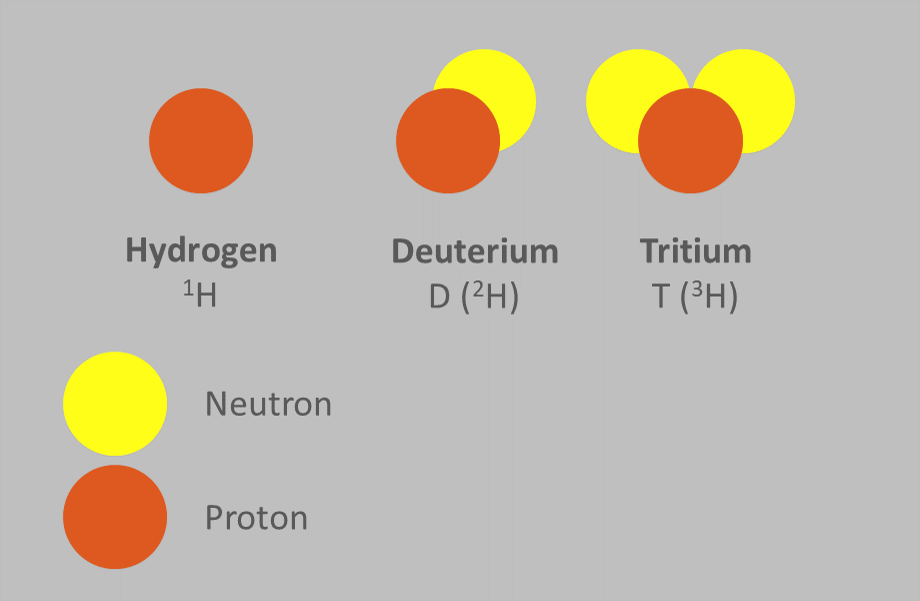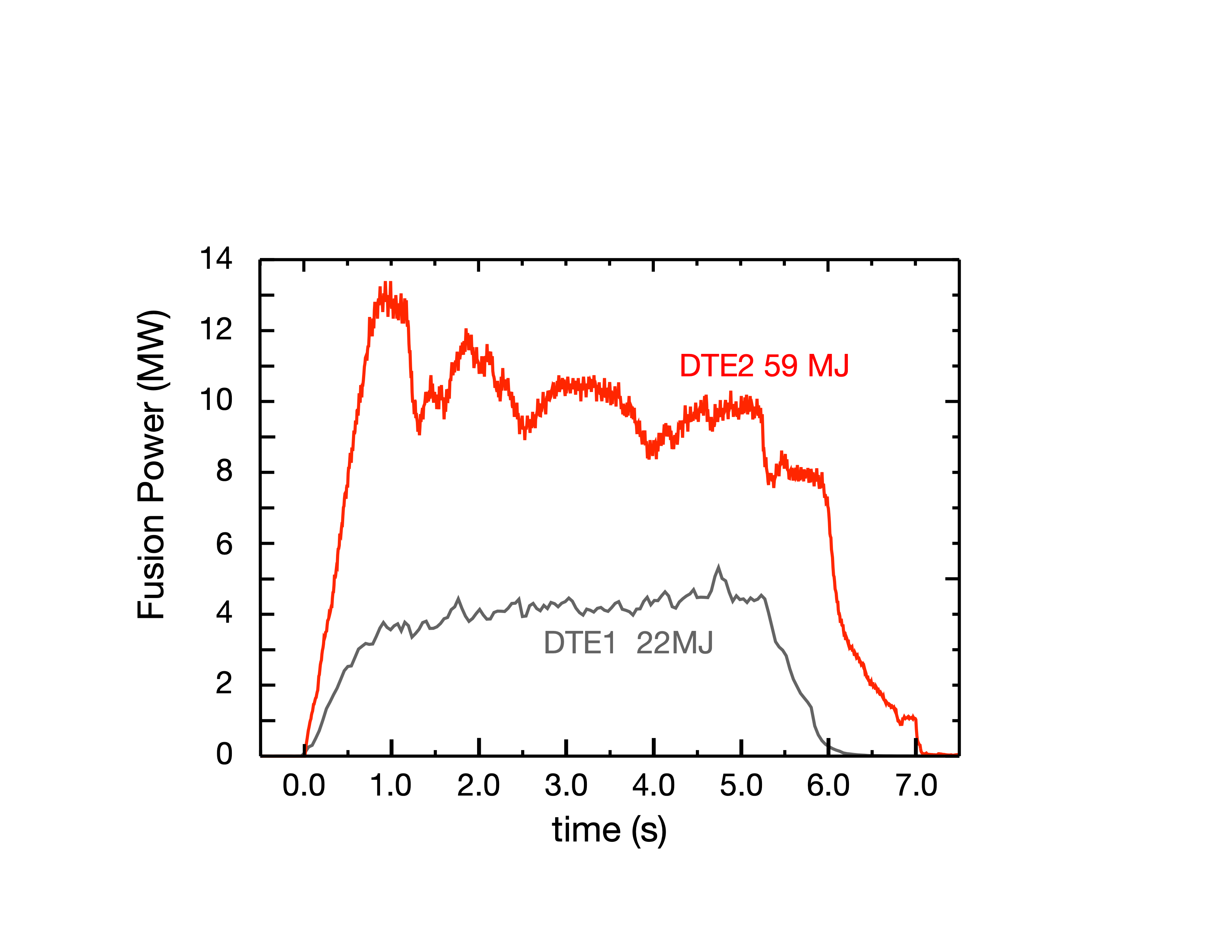Fusion is the energy source of all the light and heat from the Sun and the stars, and has the potential of providing safe, sustainable and low-carbon baseload energy that complements other clean energy sources like wind and solar. Fusion could potentially supply a significant* share of the world’s energy for many thousands of years.
The fusion process brings together light atoms like hydrogen at extremely high temperatures. At over a hundred million degrees Celsius, these particles can overcome their electric repulsion and fuse together to form heavier nuclei like helium, releasing tremendous amounts of energy.
In a fusion device or tokamak, the fusion fuel is heated until the atoms are ionised - they divide into positive ions and negative electrons. The electrons and ions then form a plasma, a soup of charged particles that is captured in a magnetic cage to prevent it from cooling due to contact with the inner wall of the device.
Once the plasma is produced, researchers optimise its fusion performance**. For instance, state-of-the-art measurement devices (diagnostics), and advanced predictive computer models linked to control systems like gas puffing and microwave cannons can adjust the pressure, ion and electron temperature, stabilising electrical currents and other processes in the complex, magnetised plasma environment.

FUSION REACTION
Credit: the EUROfusion consortium
The ultimate goal of the 30 EUROfusion consortium members in 28 European countries is to develop a demonstration power plant called ‘EU DEMO’ for short.
To develop EU DEMO, Europe has agreed on the Fusion Roadmap, the most detailed and comprehensive fusion R&D plan in the world. The European Research Roadmap to the Realisation of Fusion Energy includes all the necessary research and technology development to move fusion from the lab to the application phase together with industry.
In a fusion device or tokamak, the fusion fuel is heated until the atoms are ionised - they divide into positive ions and negative electrons. The electrons and ions then form a plasma, a soup of charged particles that is captured in a magnetic cage to prevent it from cooling due to contact with the inner wall of the device.
In this Roadmap, the EUROfusion programme’s fusion device, JET, and the international fusion project, ITER, are important stepping stones to realising EU DEMO.
- JET's experiments in 2021 with the deuterium-tritium fusion fuel mix intended for ITER and future fusion power plants will allow ITER to hit the ground running when it starts its own deuterium-tritium experiments in 2035.
- JET is the only fusion experiment in the world where researchers can already experiment and gain experience with similar conditions as in ITER, creating a partly self-heating plasma that releases a significant amount of fusion energy.
- ITER is under construction in southern France. In December 2035, ITER is scheduled to begin deuterium-tritium (D-T) operations. ITER aims to become the first experimental fusion device in the world to produce ten times more deuterium-tritium fusion energy than the input energy injected into the fuel*.
- The European EU DEMO demonstration power plant will go beyond ITER to produce more net electricity than is used in the entire plant, producing net fusion energy for electricity generation for the first time.

FUSION POWER PLANT
Credit: UKAEA
-
megajoules per kilogram
337.3 million -
equivalent to...
1 kg D-T
-
megajoules per kilogram
80.6 million -
equivalent to...
4.2 kg uranium
-
megajoules per kilogram
53.6 -
equivalent to...
6.3 million kg methane
-
megajoules per kilogram
29.5 -
equivalent to...
11.4 million kg anthracite
- Plasma radius
- Plasma volume
- Maximum plasma pulse duration
- Magnetic field
- Fusion power
- External plasma heating
- Performance (fusion power / external heating)
- Produce electricity?
- First plasma
- First tritium plasma
-
JET (1997)
2.96 meters -
JET (2021)
2.96 meters -
ITER
6.2 meters -
EU-DEMO
9 meters
-
JET (1997)
83 m3 -
JET (2021)
79 m3 -
ITER
840 m3 -
EU-DEMO
2519 m3
-
JET (1997)
30 seconds, of which 5 seconds** at high power -
JET (2021)
30 seconds, of which 5 seconds** at high power -
ITER
1000 seconds -
EU-DEMO
2 hours
-
JET (1997)
3.45 Tesla -
JET (2021)
3.45 Tesla -
ITER
5.3 Tesla -
EU-DEMO
5.9 Tesla
-
JET (1997)
16 MW heat -
JET (2021)
10-15 MW heat for 5 seconds** -
ITER
500 MW* heat for more than 300 seconds (objective) -
EU-DEMO
2000 MW of heat, 500 MW of electricity*** (objective)
-
JET (1997)
24 MW heat -
JET (2021)
40 MW heat -
ITER
50 MW heat -
EU-DEMO
50 MW heat
-
JET (1997)
0.67 (realised) for 0.15 seconds, or 0.18 for 5 seconds** -
JET (2021)
0.25 to 0.375 for 5 seconds** (targeted) -
ITER
10 (objective) -
EU-DEMO
40 (objective)
-
JET (1997)
No -
JET (2021)
No -
ITER
No -
EU-DEMO
Yes
-
JET (1997)
25 June 1983 -
JET (2021)
<< -
ITER
Dec 2025 -
EU-DEMO
~2055
-
JET (1997)
9 November 1991 (world’s first D-T plasma) -
JET (2021)
<< -
ITER
Dec 2035 -
EU-DEMO
~2055
The ideal fusion fuel is a mix of the heavy hydrogen isotopes deuterium and tritium* (D-T); hydrogen atoms with respectively one and two extra neutrons in the nucleus. Of all possible fusion fuels, this combination fuses by far the easiest and at the lowest temperature.
Only D-T fusion is predicted to release enough additional energy under realistically achievable conditions to create a surplus not only of energy in the form of heat (ITER) but also net electricity (EU DEMO).
Deuterium and tritium fuse together at a temperature of 150 million degrees Celsius to release harmless helium as well as a fast, uncharged neutron particle. The neutron serves to carry the fusion energy out of the magnetic cage into the blanket surrounding the reaction chamber, while the helium heats up the surrounding fuel to maintain fusion conditions.
The D-T fusion fuel mix being studied is seldom used in experiments because it generates massive amounts of high-energy neutrons. Each neutron moves at 52,000 km/s or 17.3% of the speed of light – so fast it could reach the moon in under 8 seconds. Special shielding is therefore required in a device using them, which limits the ease of experimenting. Tritium also requires special handling because it is radioactive. It is also extremely rare because it decays at a rate of 50% every 12.3 years (half-life of 12.3 years), so basically every atom possible must be accounted for and all un-fused tritium recovered. For this year’s experiments, JET has 60 grams of tritium sourced from a Canadian nuclear fission CANDU reactor, which are reused during the experiments.

DTE2 FUSION FUEL
Credit: the EUROfusion consortium
The JET tokamak and its science programme are a truly European project overseen by the 30 consortium members of EUROfusion.
JET is the central research facility of the European Fusion Programme, and it is the largest and most successful fusion experiment in the world on whose design the ITER project is most closely modelled. JET is collectively used under EUROfusion's management by more than 30 European laboratories, with its experiments designed and operated by over 350 scientists and engineers from the EUROfusion members.
A unique feature of JET is that it is the only tokamak* in the world that can operate using the D-T fuel planned for future fusion power plants until ITER starts operation. Almost all other fusion experiments in the world exclusively use hydrogen or deuterium plasmas. Those experiments allow researchers to study how to shape and control high-temperature plasmas without the massive amount of fast neutrons produced by the deuterium-tritium reaction. Those neutrons necessitate extra shielding and turn parts of the device radioactive, limiting the access for experiments.
While using the same fusion fuel and being equipped with a wall made of the same materials as will be used in ITER, JET is the best facility today to prepare for ITER operations. The unique capability to operate with D-T fuel allows JET to explore how the future fusion power plant fuel mix alters the processes and balance in the fusion plasma compared to just using hydrogen or deuterium.
In order to become a testbed for ITER, EUROfusion researchers and engineers have upgraded JET until it is as similar as possible to ITER. These upgrades allow fusion researchers, operators and technical support staff to gain experience under realistic ITER-like conditions and validate computer models for ITER performance even while that device is under construction. This provides vital insights for European fusion research, the operation of ITER, and the design of future fusion power plants.
JET upgrades made over the past 15 years for these D-T experiments include a change from a carbon inner wall to a metal one made out of the materials beryllium and tungsten that will be used in ITER, as well as installing additional heating, measurement and control systems.
Of the 300 scientists working on the D-T campaign at JET, a quarter belong to the younger generation that will provide continuity towards ITER. The importance of this handover in a multi-generational project like fusion cannot be overstated. After all, it will be the ITER generation that will run D-T experiments at ITER starting in 2035.
The JET campaign with deuterium and tritium in 2021 was the first time in over 20 years that a fusion experiment has run with this high-performance fuel mix. These experiments were a crucial opportunity for EUROfusion scientists to test computer models, new diagnostics, and plasma control techniques developed for ITER.
The D-T experiments in JET will prove vital for European fusion research, the operation of ITER, and the design of future fusion power plants.
New cutting edge diagnostics and advanced modelling have let EUROfusion researchers measure experimental results in one-millionth-of-a-second intervals, giving us massive amounts of data to feed the next decade of European fusion research. This will let researchers understand the behaviour of fusing D-T plasma at a level of detail not possible with earlier experiments.
The D-T experimental campaign had six main goals:
- Demonstrate fusion power from 10 up to 15 megawatts sustained for five seconds*.
- Demonstrate ways of creating and maintaining D-T plasmas in conditions representative of ITER – in particular their reaction to the plasma-facing metal wall.
- Demonstrate clear effects of the fast helium particles from the fusion reaction on plasma behaviour.
- Clarify how the different isotope masses affect energy and particle transport in the plasma.
- Study the interaction between the hot plasma and the device wall.
- Demonstrate microwave heating schemes relevant to ITER D-T operation.
These experiments were also a one-of-a-kind opportunity to transfer skills and expertise from one generation of fusion researchers to the next, who will in turn share it with the rest of the world at ITER.
The planned five-second high-energy plasma discharges in D-T experiments were limited by JET's existing copper magnets and their cooling systems, which can only handle the heat load for 5 seconds. JET's successor ITER is outfitted with cryogenically-cooled superconducting magnets, which do not heat up in this way and will be able to maintain the required magnetic field indefinitely.
Unlike its successor ITER, JET is not able to produce more heat from fusion than needed to keep the plasma at fusion temperatures. As a research facility, its value lies not in maximising fusion output, but in allowing scientists to study and optimise the processes involved.
An important parameter to consider is the total volume of plasma in JET, which is directly related to the plasma output. JET's current plasma volume is 79 m3, significantly smaller than that of ITER (840 m3). Upgrades to JET since 1997 have made it closer to ITER in terms of machine characteristics and plasma behaviour, but have slightly reduced the original plasma volume, which was about 83 m3.
In 1997 JET set three fusion world records.
JET’s first world record, which was eclipsed by the attention given to the Q = 0.67 result (see below), was a total fusion energy record from a steady-state plasma that generated ~4.5 megawatts of fusion power for 5 seconds, for a total of 22 megajoules of fusion energy created (see graph below).
JET also set a peak fusion power record of 16 megawatts during a sharply-peaked plasma pulse lasting just 0.15 seconds (see graph below). A “transient” plasma regime like this one is nowhere near as valuable as stable, sustained ones are to researchers, the operation of ITER, and the design of future fusion demonstration power plants.
Finally, the same 0.15 second pulse (another name for a plasma shot) also set a record commonly called “Q” or more accurately as Qplasma. Qplasma is calculated by dividing the plasma power by the input heating power. JET reached a record Q of 0.67 calculated from 16 megawatts (MW) fusion power divided by 24 MW of input heating power.
While an important measure of fusion research progress, Qplasma does not take into account the losses in converting electricity into heat and heat back into electricity (with today’s technology this is between 30 to 40%), nor does it consider the energy used by the experimental device, systems and facility. To truly break even, a fusion device has to reach Qplasma of at least 10, which is a goal of the ITER project. The European demonstration power plant DEMO’s goal is to reach Qplasma = 50.
In the 2021 JET D-T campaign, researchers looked to break the fusion record that matters most to the EUROfusion programme’s ultimate goal of making fusion an energy option as soon as possible: the total amount of fusion energy released by deuterium-tritium fusion in the plasma. This meant creating and sustaining steady plasmas generating around 10 megawatts of fusion power for 5 seconds.
These higher energy steady-state plasmas are possible thanks to a better knowledge of advanced plasma scenarios, and to additional installed plasma heating capacity at JET, which was increased from 24 megawatts in 1997 to nearly 40 megawatts today – an increase of two-thirds.
While five seconds may not sound like a long time, it is ten times the relevant lifetime of processes in the plasma and thus represents steady-state operation. It will be relatively straightforward to extend this plasma duration in future machines with superconducting magnets that can maintain the magnetic field for longer.

FUSION OUTPUT COMPARISON 1997 and 2021
Credit: the EUROfusion consortium

 English
English  Italiano
Italiano